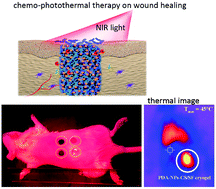Mussel-inspired cryogels for promoting wound regeneration through photobiostimulation, modulating inflammatory responses and suppressing bacterial invasion†
Abstract
Wound healing is a complex and dynamic process, and involves a series of events, which create a unique microenvironment at the wound sites. It is highly desirable to develop multi-functional skin substitutes which can play their roles in the whole healing processes to enhance the final healing efficiency. Herein, we fabricated a mussel-inspired chitosan/silk fibroin cryogel functionalized with near-infrared light-responsive polydopamine nanoparticles (PDA-NPs), as a multifunctional platform to regulate the wound microenvironment and enhance efficient wound healing. The cryogel has an extracellular matrix-like macroporous structure, mimicking the natural tissue environment, which allows cell attachment and tissue ingrowth. The cryogel shows high anti-oxidative activity to eliminate overproduced reactive oxygen species during inflammatory responses. Furthermore, the cryogel exhibits photothermally assisted antibacterial activity to prevent bacterial invasion. Thus, by combining the photobiostimulation of infrared light, the cryogel realizes bio-chemo-photothermal synergistic therapy for accelerating the complete skin-thickness wound healing by simultaneously suppressing adverse events due to its antibacterial activity and anti-oxidative ability, and promoting cell activities and tissue regeneration. Our work therefore presents the great promise shown by this multifunctional biopolymer cryogel as a flexible wound dressing with combinatory therapy for accelerating wound healing.



 Please wait while we load your content...
Please wait while we load your content...